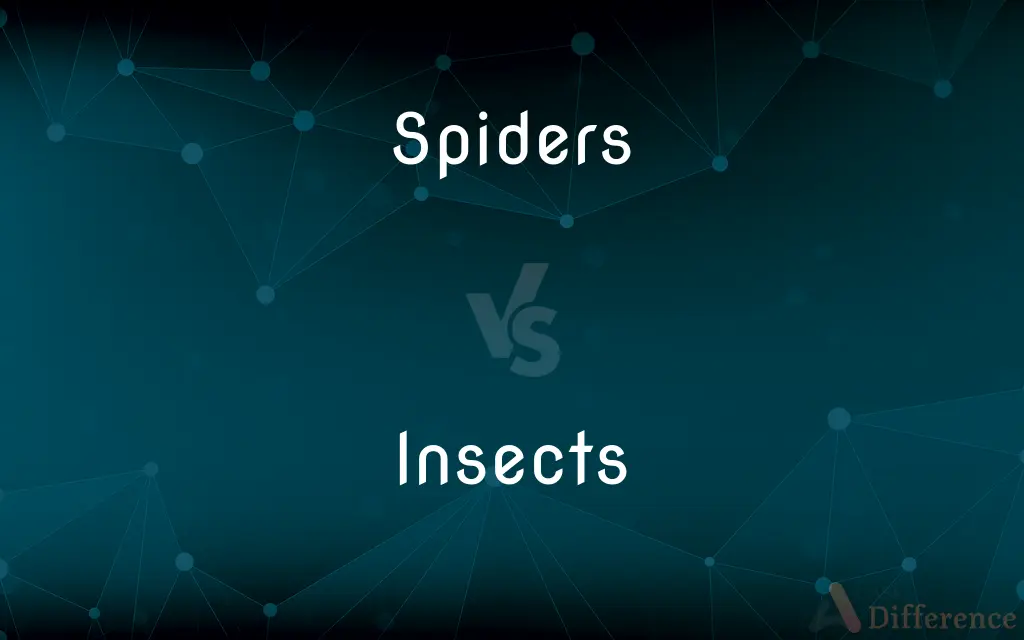Spiders vs. Insects — What's the Difference?
Edited by Tayyaba Rehman — By Fiza Rafique — Published on December 28, 2023
Spiders are arachnids with eight legs; Insects are hexapods with six legs and three main body parts.

Difference Between Spiders and Insects
Table of Contents
ADVERTISEMENT
Key Differences
Spiders, belonging to the class Arachnida, are eight-legged creatures known for spinning intricate webs. Their bodies consist of two main segments: the cephalothorax and the abdomen. These creatures are skilled predators, often relying on their webs or venom to capture prey.
Insects, in contrast, are members of the class Insecta and are characterized by their three-part bodies: the head, thorax, and abdomen. They possess six legs and typically have both antennae and wings. Insects are incredibly diverse, with millions of species found across various habitats.
While Spiders primarily consume a carnivorous diet, feeding on smaller animals, Insects have varied diets. Some insects, like butterflies, sip nectar from flowers, while others, like locusts, consume plant matter. Still, others might be predators or scavengers.
In the world of reproduction, Spiders employ a unique method. The male typically deposits sperm into a special structure and then transfers it to the female. Insects, on the other hand, usually mate directly, with males transferring sperm to females. Their reproductive strategies and life cycles are diverse and adapted to their specific environments.
In essence, while both Spiders and Insects play crucial roles in ecosystems as predators, prey, or pollinators, their biological structures and life histories showcase the vast diversity and complexity of the animal kingdom.
ADVERTISEMENT
Comparison Chart
Class
Arachnida
Insecta
Number of Legs
Eight
Six
Body Segments
Two (cephalothorax and abdomen)
Three (head, thorax, abdomen)
Antennae
Absent
Typically present
Wings
Absent
Typically present (but can vary)
Compare with Definitions
Spiders
Eight-legged arachnids that spin webs.
Spiders can be found in almost every continent of the world.
Insects
Hexapods with three body parts and six legs.
Butterflies and beetles are both common insects.
Spiders
Predatory creatures with venomous bites.
Some spiders have venom potent enough to harm humans.
Insects
Organisms often having antennae and wings.
Moths, unlike some insects, are nocturnal flyers.
Spiders
Masters of ambush and trap-based hunting.
Garden spiders weave intricate webs to catch flying insects.
Insects
Critical pollinators in many ecosystems.
Without insects like bees, many plants wouldn't reproduce.
Spiders
Members of the class Arachnida.
Besides spiders, scorpions are also part of the Arachnida class.
Insects
The most diverse group of animals on Earth.
Scientists have described over a million species of insects.
Spiders
Organisms with two primary body segments.
Spiders have a distinct cephalothorax and abdomen.
Insects
Members of the class Insecta.
Ants, with their complex societies, are fascinating members of the Insecta class.
Spiders
Any of numerous arachnids of the order Araneae, having a body divided into a cephalothorax and an abdomen, eight legs, two chelicerae that bear venom glands, and two or more spinnerets that produce the silk used to make nests, cocoons, or webs for trapping insects.
Insects
Any of numerous arthropod animals of the class Insecta, having an adult stage characterized by three pairs of legs and a body segmented into head, thorax, and abdomen and usually having one or two pairs of wings. Insects include the flies, crickets, mosquitoes, beetles, butterflies, and bees.
Spiders
One that resembles a spider, as in appearance, character, or movement.
Insects
Any of various other small, chiefly arthropod animals, such as spiders, centipedes, or ticks, usually having many legs. Not in scientific use.
Spiders
A program that automatically retrieves webpages and follows the links on them to retrieve more webpages. Spiders are used by search engines to retrieve publicly accessible webpages for indexing, and they can also be used to check for links to webpages that no longer exist. Also called crawler, search bot.
Insects
An insignificant or contemptible person.
Spiders
New England, Upper Northern, & South Atlantic US See frying pan.
Insects
Plural of insect
Spiders
A trivet.
Spiders
Plural of spider
Spiders
Infl of spider
Common Curiosities
Can all Insects fly?
Not all insects have wings, and among those that do, some might not fly.
Do all Spiders weave webs?
No, while many spiders spin webs, some, like jumping spiders, do not.
How many species of Insects are there?
Over a million species of insects have been described, but many more remain undiscovered.
What are Spiders?
Spiders are eight-legged arachnids known for spinning webs and having venom.
Are all Insects beneficial for the environment?
While many insects play crucial ecological roles, some can be pests or harmful.
Do Spiders belong to the Insecta class?
No, spiders belong to the Arachnida class.
Which is more diverse, Spiders or Insects?
Insects are more diverse, with millions of species compared to the thousands of spider species.
What's the primary diet of Spiders?
Spiders are primarily carnivorous, preying on other smaller animals.
How do Insects reproduce?
Insects have diverse reproductive strategies, but most mate directly with males transferring sperm to females.
What's the lifespan of Spiders?
Lifespans vary, but many spiders live for a year, with some species living longer.
What defines Insects?
Insects are organisms with six legs, three body parts, and often possess antennae and wings.
Are all Spiders venomous?
Most spiders have venom, but not all are dangerous to humans.
Why are Insects important to humans?
Insects pollinate crops, decompose waste, control pests, and serve as food for other animals, among other roles.
What roles do Insects play in ecosystems?
Insects can be predators, prey, pollinators, decomposers, and more.
How do Spiders catch their prey?
Many use webs, but others use ambush tactics, hunting, or burrowing.
Share Your Discovery

Previous Comparison
Consulate vs. Honorary Consulate
Next Comparison
Idaho Potatoes vs. Russet PotatoesAuthor Spotlight
Written by
Fiza RafiqueFiza Rafique is a skilled content writer at AskDifference.com, where she meticulously refines and enhances written pieces. Drawing from her vast editorial expertise, Fiza ensures clarity, accuracy, and precision in every article. Passionate about language, she continually seeks to elevate the quality of content for readers worldwide.
Edited by
Tayyaba RehmanTayyaba Rehman is a distinguished writer, currently serving as a primary contributor to askdifference.com. As a researcher in semantics and etymology, Tayyaba's passion for the complexity of languages and their distinctions has found a perfect home on the platform. Tayyaba delves into the intricacies of language, distinguishing between commonly confused words and phrases, thereby providing clarity for readers worldwide.











































